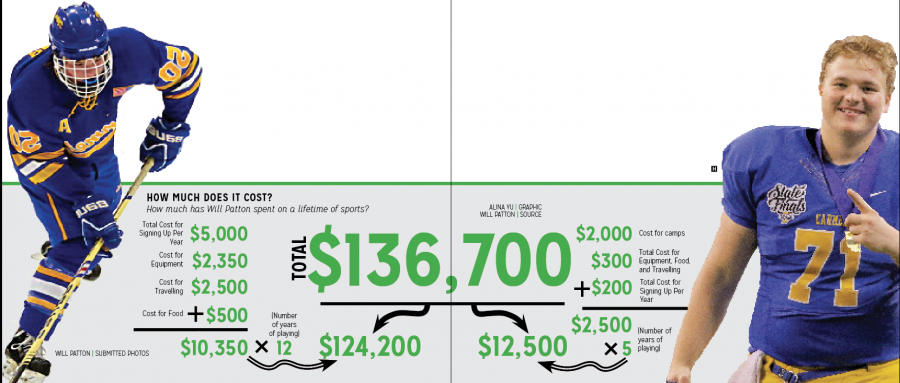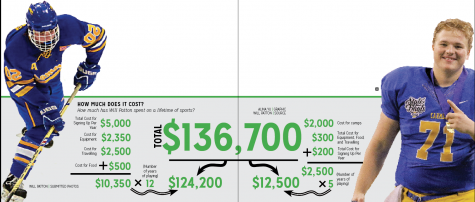THE COST OF SUCCESS: While varsity athletes excel on the court, it can take a lot of money to get to that level
Brooke Grigsby, volleyball player and junior, plays for both the Munciana Volleyball Club and CHS varsity team. Playing at Munciana Volleyball can become costly even before tournaments and practices start.
“We have to pay for tryouts; tryouts this year were $500. After tryouts, we have to pay for all new uniforms, shoes, knee pads, all of the tournament fees (and) coaches fees,” Grigsby said.
There are other costs as well.
“(For CHS), we have to donate money to the booster club, and there’s not really a booster club for club (sports); it’s usually just a team mom,” Grigsby said. “Also, we go to nationals during the club season. Nationals and the plane ticket there (are) probably the most expensive thing throughout the club season.”
Some athletes, like Grigsby, may even pay for extra physical conditioning or personal training during their off seasons. “We do some conditioning. The school sometimes has clinics, and then me and a few girls go to a lady that we’ve always gone to, to get that extra conditioning,” Grigsby said.
For children ages 6 to 16, approximately 25 million participate in school sports, and 20 million participate in out-of-school sports. Athletes and their parents, therefore, have to find ways to pay for those sports in and out-of-school. According to Travis Dorsch, Utah State University youth sports assistant professor, families could be spending up to 10.5 percent of their income just on their children’s sport(s).
Olivia Christy, basketball player and senior, has been playing basketball since she was in second grade, and she said she hopes to play in college. If she continues with basketball and plays throughout college, her parents will have paid for 15 years of basketball.
According to Christy, the cost may include “travel, uniforms, basic club dues that probably go to the coaches and helping pay for practice facilities, shoes and socks and backpacks.”
Traveling is also an important factor of the cost of a sport. Christy’s basketball team travels often, which can become costly.
“During the school year at least half of our games are road games, which would be about once a week,” Christy said. “For travel, I would say that every weekend during the spring we usually go somewhere (as far as) Georgia or Cincinnati.”
Assistant Athletics Director Bruce Wolf said he recognizes the impact school sanctioned sports have on the costs for CHS’s athletes.
“In school, you can get buses for transportation, which means the costs don’t go to the family. And in club, the player typically buys his own equipment. So those would be the two biggies, equipment and transportation,” Wolf said. “In most cases, they are covered in a school sanctioned sport, where it might not in a non-school sanctioned sport.”
Will Patton, football and hockey player and senior, has been playing hockey for 14 years and football for 12 years. He first started playing the sports after his dad introduced him to both hockey and football. Patton said he ended up loving them both.
“Although it’s very expensive, it is definitely worth it. It is a great experience,” Patton said via email.
Every so often players have to replace their equipment, sometimes they’ve outgrown it or they’ve damaged their equipment. The cost of replacing specific pieces can become costly, but in some cases the school will cover the costs.
Patton said, “Every (piece of equipment) other than sticks are replaced about every two years, which can cost around $800. I go through about six sticks a year, and each stick costs $250. For football, there is no cost for equipment replacement because it is provided by the school.”
Grigsby said she has to buy a specific brand clothing each year for each team she plays on. “For Munciana, we only wear Asics, everything is Asics. You can get fined if you don’t wear (Asics) for a tournament. Then for (CHS) everything is Nike,” Grigsby said.
Patton said he wants to play hockey in college. In order for coaches to see his performance, Patton and his family must pay for ways to promote him.
“(For hockey) I am on a select team Indiana hockey team that plays in showcase tournaments where scouts come to watch. This costs about $3,000, but it really helps me try to promote myself. (For football), I have spent about $2,000 on special football camps to try to promote myself,” Patton said.
Patton said he knows that both sports can become a big cost commitment, which is why he has to decide if the cost is worth it.
“Sometimes I have to think and make sure the high costs are worth it, but they are always worth it because of the experiences I gain from playing the sport,” Patton said.
Christy said that playing basketball is worth the cost. “It is worth it because you meet a lot of people and get to have a lot of different experiences,” Christy said.
Patton said he also agrees the cost is worth it. Patton said “Hockey is a very large cost commitment, as it is not a school-sponsored sport. Although it is a big cost to play, it is very well worth it. Football is not a big cost commitment at all, and you get so much out of playing football. You get and amazing experience playing football.”


